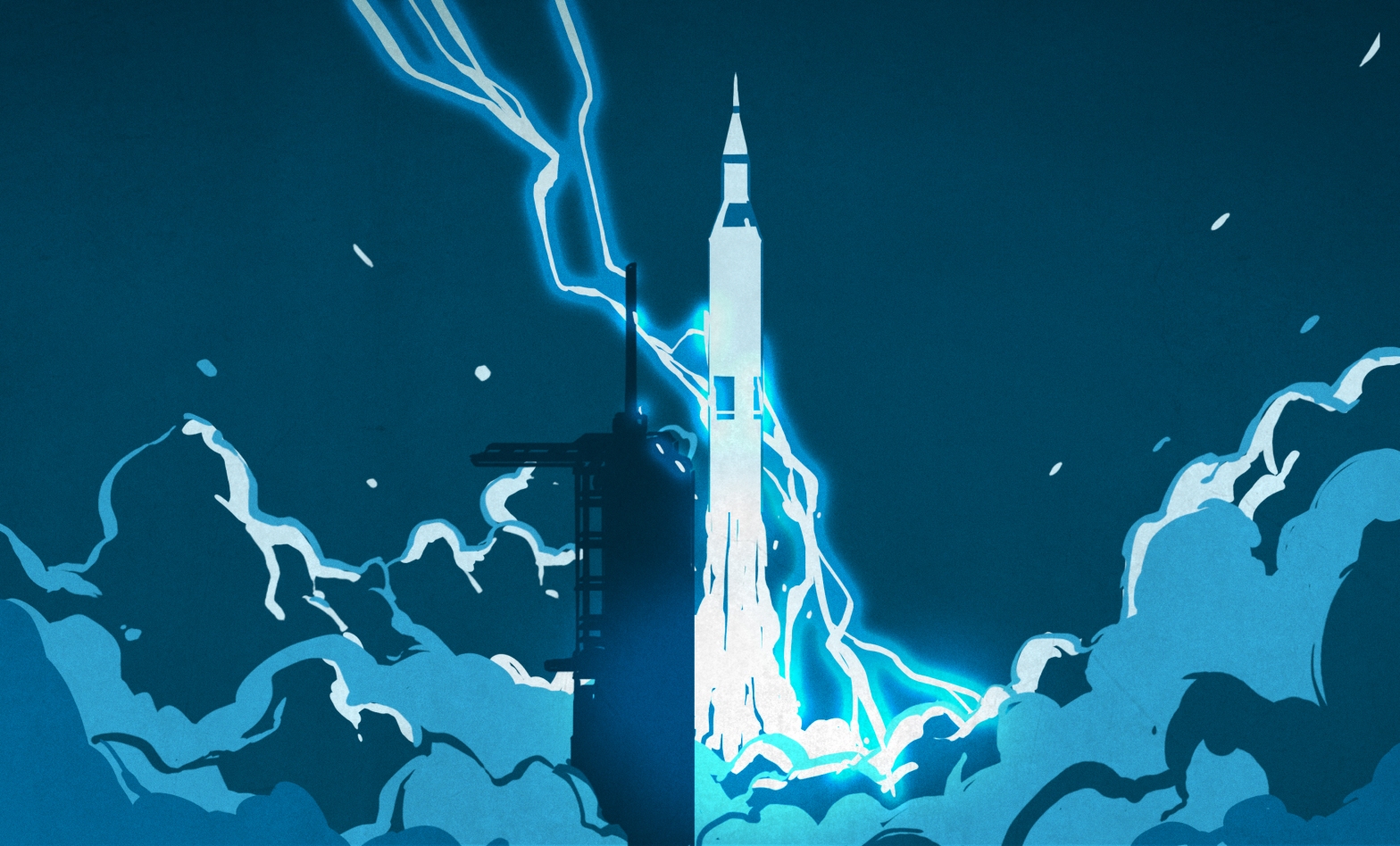The day was 14th November 1969, the place was Launch Complex Pad 39A. The enthusiastic atmosphere on the ground was in stark contrast to the gloomy overcast skies accompanied by light rain, as it was about time for the Apollo 12 astronauts Charles “Pete” Conrad, Richard Gordon and Alan Bean to lift-off aboard the mighty Saturn 5 rocket. It was concluded that the current weather conditions would not pose any serious threat to the mission and hence the mission would lift-off as originally scheduled. After all the final launch preparations were completed, the rocket experienced a smooth and nominal lift-off at 11:22 am EST before roaring into the unclear skies. However, smooth and nominal is not how anyone would describe the rest of their journey to orbit.

Lift-off of Apollo 12
About 36 seconds after launch at an altitude of over 2km, the crew experienced a flash of light and a jolt. A sudden power surge was experienced that caused almost all the instrument panel warning lights to light up, an event that no astronaut had ever prepared for in the countless hours they spent in flight simulation. Though unaware of it at the moment, the astronauts and crew would eventually come to realise that they just became the highest and fastest lightning rod in history.
Unfortunately for them, this was just the beginning. Just 16 seconds after the incident, the rocket was struck by a second bolt of lightning which rendered the situation much worse: the main power supply was cut off, all instrument panel warning lights had suddenly disappeared and all the systems had crashed. The backup batteries had started kicking in, however, they were only designed to last for a couple of hours, not the entire mission duration of 10 days. Finally, to make matters worse, mission control in Houston were receiving garbled telemetry values and therefore had no clue as to what was happening.
The crew had 90 seconds to solve the issues before being forced to abort. What followed was a near 20-second period of radio silence in the most crucial period of crisis, further testing the nerves of the astronauts who were strapped in helplessly as the rocket accelerated into space with all computer aids seemingly dead. Finally, after 50 seconds since the multiple system failure, John Aaron, the Electrical, Environmental and Consumables Manager (EECOM) came up with a suggestion: “Try SCE to AUX.”
While this command sounded perfectly simple, in reality, it puzzled not only the Flight Director but also the CAPCOM (CAPsule COMmunication: The person in ground control in charge of communication with astronauts) and the astronauts themselves as this switch was rarely ever used during the simulations. As it turned out, the set of mangled data being received had a pattern that Aaron recognised eventually; it was the same pattern that he witnessed a year ago when an accidental drop in voltage during testing affected the Signal Conditioning Equipment (SCE), an equipment responsible for converting the raw output from sensors into standard voltages, enabling information to be displayed in the instruments as well as transmitted back to Houston. On switching the SCE to the auxiliary power mode (AUX), the SCE operated at a lower voltage, restoring the instrument panel readings and the fuel cells, which in this case had been disconnected due to the power surge, as it was later discovered, could be rebooted to resume normal operations.
The CAPCOM relayed the command to the astronauts, which thoroughly puzzled both Conrad and Gordon. Luckily, however, Lunar Module Pilot Alan Bean remembered the switch from a previous simulation and threw it. Soon enough, the instrument panels lit up and data transmission was nominal again. After a simple reset of the fuel cells, the power returned and the mission continued on as if nothing happened and the astronauts laughed off the incident all the way to orbit.
It was with the help of a calm mind and some quick thinking from Aaron and Bean’s sharp memory that a major crisis was averted. Aaron’s calm nerves in the high-pressure situation that enabled him to come up with a solution that no one else could earned him the nickname ‘Steely-eyed missile man’.
However, the crew were not completely out of danger yet, as there was still the possibility of the lightning strikes having damaged some of the critical systems and components, such as the parachute. However, since there were no sensors installed there, there was no real way of knowing. Therefore, since nothing could be done about the situation, ground control and the astronauts decided to continue on with the mission. In an interview with NPR in 2014, Bean spoke about their decision to continue the mission, saying, “They apparently talked it over at the highest levels and decided, ‘Well, if it did do something wrong to the spacecraft, like the parachute system or something like that, if we had them enter now they’d get killed earlier than if we sent them to the moon and let them do whatever else they’re doing there and then come back 10 days later and if their parachutes don’t work then, well … at least they’ve had 10 days in a great adventure.“
In the end, however, the parachutes did turn out to be unharmed as they were deployed seamlessly, gently bringing the 3 astronauts down to a safe splashdown 10 days later on 24th November 1969 near American Samoa, thus bringing to an end an incredible journey of these astronauts of immense courage and indomitable spirit to the moon and back.

Apollo 12 Crew: (L) Charles “Pete” Conrad, (C) Richard Gordon, (R) Alan Bean
Kiran Nandanan
Final Year Mechanical
